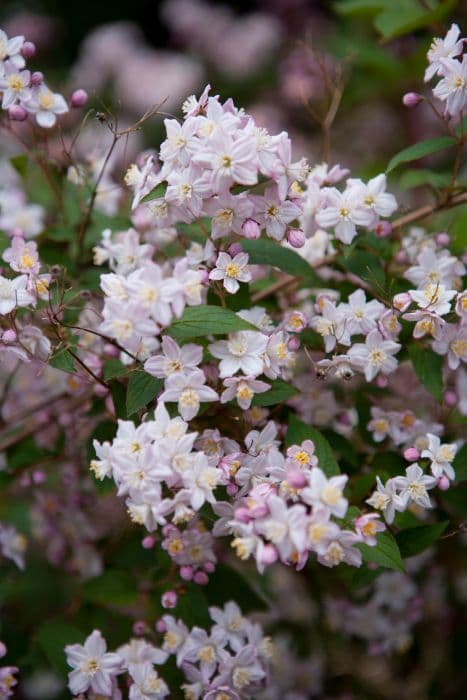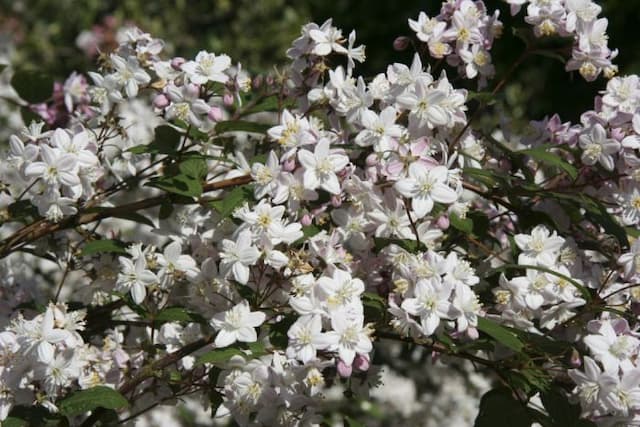American Jameswort Jamesia americana

ABOUT
Jamesia americana, commonly known as waxflower or cliffbush, is a deciduous shrub which is notable for its distinctive appearance. It typically grows in clumps and is characterized by its branching habit. The waxflower has dark green, serrated leaves that are oval to heart-shaped, lending the foliage a lush, textured appearance. During the blooming period, the waxflower produces clusters of strikingly beautiful flowers. These blossoms are white to cream-colored, and they exude a delightful fragrance. The flowers are particularly notable for their five-petalled, cup-shaped form, which can occasionally appear with hues of pink depending on the variety. Due to their waxy appearance and feel, they've been aptly named waxflowers. After the flowering season, the plant develops capsules that contain numerous small seeds. These capsules add an additional element to the plant's visual interest throughout the year. The waxflower's bark is another characteristic aspect, often being flaky or peeling in texture, which contributes to its rustic appeal. This attribute becomes more pronounced as the plant matures. The combination of its appealing foliage, enchanting flowers, and the textural bark renders the waxflower a desirable plant for garden enthusiasts looking for an aesthetically pleasing shrub. It's also commonly used in floral arrangements and bouquets due to its visually attractive blooms.
About this plant
 Names
NamesFamily
Hydrangeaceae.
Synonyms
American Jamesia, Cliffbush, Waxflower, Fivepetal Cliffbush, Five-petal Cliffbush.
Common names
Jamesia americana var. rosea, Jamesia americana var. americana.
 Toxicity
ToxicityTo humans
Jamesia americana, commonly known as cliffbush, is not widely recognized for its toxicity to humans. There is limited information on cliffbush causing poisoning upon ingestion. However, as with any plant, individual allergies or reactions can occur. If a person has consumed cliffbush and is experiencing adverse effects, it is important to contact a medical professional or poison control for guidance.
To pets
There is no well-documented evidence to suggest that Jamesia americana, known as cliffbush, is toxic to pets. However, the absence of documented toxicity does not guarantee that it is safe. Pets may have unique sensitivities, and ingestion of non-food plants can sometimes lead to gastrointestinal upset or allergic reactions. If your pet has ingested cliffbush and exhibits signs of distress, consult your veterinarian for advice and treatment.
 Characteristics
CharacteristicsLife cycle
Perennials
Foliage type
Deciduous
Color of leaves
Green
Flower color
White
Height
3-4 feet (0.9-1.2 meters)
Spread
3-4 feet (0.9-1.2 meters)
Plant type
Shrub
Hardiness zones
4
Native area
North America
Benefits
 General Benefits
General Benefits- Landscaping: Waxflower shrubs can enhance the aesthetic appeal of gardens with their attractive foliage and flowers.
- Habitat for Wildlife: They provide food and shelter for various species of birds and insects, contributing to biodiversity.
- Erosion Control: The plant's root system can help stabilize soil and reduce erosion on slopes.
- Drought Resistance: Waxflower is adapted to survive with limited water, making it suitable for xeriscaping.
- Seasonal Interest: With its seasonal blooms, it adds visual interest to gardens throughout its flowering period.
- Low Maintenance: It requires minimal care once established, making it a convenient choice for gardeners.
 Medical Properties
Medical PropertiesThis plant is not used for medical purposes.
 Air-purifying Qualities
Air-purifying QualitiesThis plant is not specifically known for air purifying qualities.
 Other Uses
Other Uses- Ornamental Value: Jamesia americana, commonly known as cliffbush, is used for ornamental purposes in gardens and landscapes, particularly for its attractive clusters of white flowers that bloom in spring and early summer.
- Artistic Inspiration: The delicate beauty of cliffbush has inspired artists and photographers who specialize in botanical subjects and natural landscapes.
- Educational Tool: Cliffbush can be used in educational settings, such as botanical gardens or naturalist programs, to teach about native plant species and their role in local ecosystems.
- Erosion Control: With its ability to grow in rocky areas, Jamesia americana can be planted on slopes or areas prone to erosion to help stabilize the soil with its root system.
- Wildlife Food Source: The flowers of cliffbush provide nectar for pollinators such as bees and butterflies, while its seeds may be consumed by various bird species.
- Shelter for Small Animals: The dense foliage of Jamesia americana offers shelter and nesting sites for small birds and mammals in its native habitats.
- Horticultural Breeding: Jamesia americana is sometimes used in breeding programs to create new ornamental plant varieties with desirable characteristics.
- Cultural Significance: Some Native American tribes may have used cliffbush in traditional ceremonies or stories, reflecting a spiritual or cultural importance of the plant.
- Photography Subject: The striking appearance of cliffbush when in bloom makes it a popular subject for nature photographers, especially in its natural mountainous settings.
- Scented Gardens: The flowers of Jamesia americana are fragrant and can contribute a pleasant aroma to gardens designed around the sensory experience.
Interesting Facts
 Feng Shui
Feng ShuiThe Waxflower is not used in Feng Shui practice.
 Zodiac Sign Compitability
Zodiac Sign CompitabilityThe Waxflower is not used in astrology practice.
 Plant Symbolism
Plant Symbolism- Resilience: Jamesia americana, commonly known as Cliff Jamesia or Waxflower, often grows in rocky, challenging environments, symbolizing the ability to endure and thrive in difficult conditions.
- Purity: The white flowers of Cliff Jamesia are sometimes associated with purity and innocence due to their color.
- Adaptability: As a plant that can adapt to less-than-ideal soil conditions and still produce beautiful flowers, Cliff Jamesia represents adaptability and the grace of making the best of one's environment.
 Water
WaterThe common snowbrush (Jamesia americana) prefers to be watered deeply yet infrequently. Water the plant by saturating the soil around the root zone until it's moist, but not soggy - this could be approximately 1 gallon of water for a small to medium-sized plant. In general, you should water the snowbrush once a week during its active growing season, but always check the soil first; it should be dry an inch below the surface before watering again. During the winter months, reduce the frequency as the plant requires less water when dormant.
 Light
LightThe snowbrush thrives in full to partial sunlight. The best spot for this plant is in an area that receives at least four to six hours of direct sunlight daily, but can also tolerate some shade. Avoid deep shade locations as this will hinder the growth and flowering of the Jamesia americana.
 Temperature
TemperatureJamesia americana, commonly known as snowbrush, is suited to a temperate climate and can handle a range of temperature conditions. It can tolerate minimum winter temperatures down to approximately 20°F, while its preferred growing conditions are between 60°F and 80°F. The snowbrush is fairly hardy but should be protected from extreme heat, which can stress the plant and scorch its leaves.
 Pruning
PruningPruning the snowbrush is necessary to maintain its shape, remove dead or diseased wood, and promote healthy growth. The best time to prune is in late winter or early spring before new growth starts. Cut back any older stems to encourage branching, and thin out the shrub to allow light and air circulation. Pruning can be done annually, but always ensure not to remove more than a third of the plant in a single season.
 Cleaning
CleaningAs needed
 Soil
SoilWaxflower thrives in well-draining soil enriched with organic matter, with a slightly acidic to neutral pH between 5.5 and 7.0. A soil mix containing equal parts loam, peat moss, and perlite or sand would be ideal to facilitate drainage and mimic the plant's native mountainous habitats.
 Repotting
RepottingWaxflowers do not require frequent repotting and can typically be repotted every 2-3 years or when they outgrow their current container. It's best to repot during the spring, just before the growing season begins.
 Humidity & Misting
Humidity & MistingWaxflower plants prefer moderate humidity levels, which can usually be maintained in a typical home environment without the need for additional humidity control methods.
 Suitable locations
Suitable locationsIndoor
Place Waxflower in bright, indirect light and ensure good air circulation.
Outdoor
Plant Waxflower in partial shade with moist, well-draining soil.
Hardiness zone
4-8 USDA
 Life cycle
Life cycleJamesia americana, commonly known as the American Cliffbrake or Waxflower, begins its life cycle as a seed which germinates in moist, well-drained soil, typically in shaded or rocky woodland environments. Upon sprouting, the seedling establishes a root system and grows into a young plant, featuring its characteristic heart-shaped leaves. As the plant matures, it develops into a woody shrub that can reach up to three feet in height. During its flowering stage, usually from late spring to early summer, Jamesia americana produces clusters of fragrant, white to pinkish flowers. After pollination, typically by insects like bees, the plant forms capsule-like fruits which disperse its seeds, allowing for the propagation of the next generation of plants. Throughout the years, the shrub may experience periods of dormancy in the winter before resuming growth in the following spring.
 Propogation
PropogationPropogation time
Spring-Early Summer
Jamesia americana, commonly known as Cliff Jamesia or Waxflower, can be propagated most effectively by cuttings. This technique ensures that the progeny will maintain the genetic integrity of the parent plant. Semi-hardwood cuttings are ideal and should be taken in late summer. To start, choose a healthy, non-flowering stem and cut a 4 to 6 inch (10 to 15 cm) section just below a node. Remove the bottom leaves and dip the cut end in rooting hormone to encourage root growth. The cutting can then be placed in a moist potting mixture, ensuring at least one node is below the surface. Covering the potted cutting with a plastic bag to retain moisture can create a greenhouse effect, promoting root development. Keeping the soil consistently moist but not waterlogged and providing indirect light will encourage successful rooting in several weeks.







![Hydrangea [Early Sensation]](/_next/image?url=https%3A%2F%2Fplants-admin.emdemapps.com%2Fimages%2Fplants%2F%2Fimages%2F604b6150338db.png&w=640&q=75)

